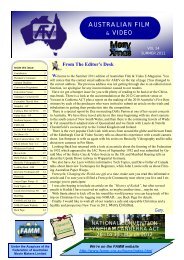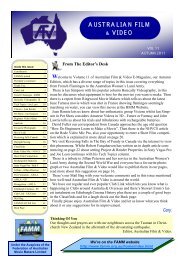Australian film - Federation of Australian Movie Makers
Australian film - Federation of Australian Movie Makers
Australian film - Federation of Australian Movie Makers
Create successful ePaper yourself
Turn your PDF publications into a flip-book with our unique Google optimized e-Paper software.
must divide evenly into the TV frames per second, or a multiple there<strong>of</strong>”.<br />
(Multiples <strong>of</strong> PAL TV being 25, 50, 75, 100, etc)<br />
HOW TO GET “INTO PHASE”<br />
TRANSFERRING 18 fps FILM (Super 8 silent) to PAL VIDEO.<br />
To get ‘into phase’, according to the formula, it is necessary to slow the projector speed down to<br />
16 2/3 frames per second.<br />
Therefore, a projector with variable speed control is essential<br />
With a 3 bladed shutter (the most common):---from the formula:<br />
3 x 16 2/3 fps = 50 ‘flicks’ per sec, which is wholly divisible by 25. So there will be no flicker resulting.<br />
Notice that exactly two <strong>film</strong> frames fills three video frames consistently along the time line. In this way there will be<br />
no exposure variations caused in the camcorder.<br />
ABOUT REALTIME SPEED<br />
Now,18 fps reduced to 16 2/3 fps is a real time speed reduction <strong>of</strong> 7.2%, a fairly considerable amount. Will it be noticeable?<br />
Probably Yes. Motion appears jerky – like the “old time flicks”. Smooth continuity <strong>of</strong> movement can be<br />
restored at the video editing stage by applying ‘Fast Motion’ at 8% to speed up the movement back to real time.<br />
You may be surprised to find what a difference this makes.<br />
The theory outlined here is for the PAL system, and the examples shown are for Super 8 silent <strong>film</strong>.<br />
Films shot at 24 fps, and 16 fps can have the projector speed calculated on the same principle.<br />
ABOUT THE DIFFERENCE IN NUMBER <strong>of</strong> FRAMES PER SECOND<br />
Because the ratio <strong>of</strong> 16 2/3 to 25 is exactly 2 <strong>film</strong> frames to 3 video frames, every third video frame will carry<br />
an image mixing two <strong>film</strong> frames. This is unavoidable. It looks dreadful when you inspect your video, a frame at a<br />
time, but when it is being played on the TV screen the “dual image” just behaves the same way as adjoining frames<br />
do normally.<br />
UNFORTUNATELY FOR NTSC USERS<br />
They have a different set <strong>of</strong> problems brought about by their TV system operating on 30 frame per sec.<br />
They need a 5 bladed projector shutter to produce 24 x 5 = 120 ‘flicks’ per second in order to be wholly divisible<br />
by 30, (that gives four flicks per TV frame).<br />
Additionally, they have a discrepancy <strong>of</strong> six picture frames per second to contend with. (24 <strong>film</strong> frames<br />
to 30 video frames, (a 25% increase in perceived speed)<br />
This is overcome by repeating every fourth <strong>film</strong> frame per second, so that the TV frames will record the<br />
<strong>film</strong> frames in the following order : 1, 2, 3, 4, 4, 5, 6, 7, 8, 8, 9, 10, 11, 12, 12, 13, 14, 15, 16, 16, 17, 18, 19,<br />
20, 20, 21, 22, 23, 24, 24, every second. The duplicated frames are not visually detectable.<br />
And that’s for <strong>film</strong> shot at 24 fps. Super 8 <strong>film</strong> at 18 fps is another problem again!<br />
Not really a job for the DIY enthusiast. Aren’t we lucky to have PAL.<br />
<strong>Australian</strong> <strong>film</strong> & video<br />
Page 55










